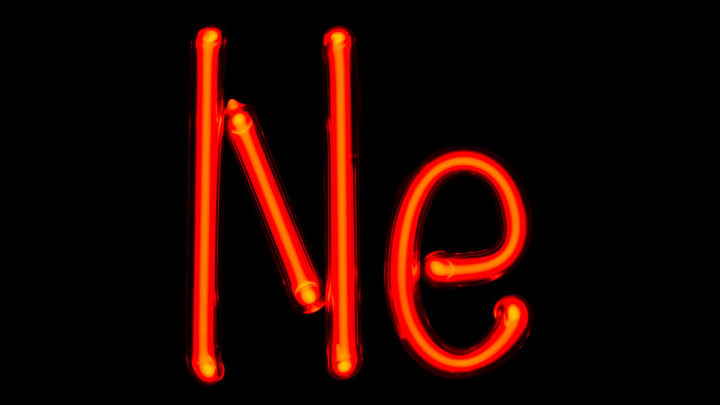8 Facts About the Element Neon

Most of us are familiar with neon as a term for bright colors and vibrant signs, but you may not know as much about the element underlying the name, which scientists were first able to isolate starting in 1898. Here are eight facts about neon—abbreviated Ne and number 10 on the periodic table— that might surprise you.
1. The element neon wasn’t William Ramsay’s first big discovery.
Sir William Ramsay already had a few elements under his belt by the time he and fellow British chemist Morris Travers became the first scientists to isolate neon. In 1894, he and physicist John Williams had isolated argon from air for the first time. Then, in 1895, he became the first person to isolate helium on Earth. But he had a hunch that more noble gases might exist, and he and Travers isolated neon, krypton, and xenon for the first time in 1898. As a result of his discoveries, Ramsay won the Nobel Prize in chemistry in 1904.
2. It’s one of the noble gases.
There are seven noble gases: helium, neon, argon, krypton, xenon, radon, and oganesson (a synthetic element). Like the other noble gases, neon is colorless, odorless, tasteless, and under standard conditions, nonflammable. Neon is highly unreactive—the least reactive of any of the noble gases, in fact—and doesn’t form chemical bonds with other elements, so there are no neon compounds. That non-reactivity is what makes neon so useful in light bulbs.
3. The name means new.
With the exception of helium, all of the noble gases have names ending in -on. The word neon comes from the Greek word for new, νέος.
4. It's pulled out of the air.
Neon is one of the most abundant elements in the universe. Stars produce it, and it’s one of the components of solar wind. It's also found in the lunar atmosphere. But it’s difficult to find on Earth. Neon is located in Earth’s mantle as well as in tiny amounts in air, which is where we get commercial neon. Dry air contains just 0.0018 percent neon, compared to 20.95 percent oxygen and 78.09 percent nitrogen, plus trace amounts of other gases. Using a process of alternately compressing and expanding air, scientists can turn most of these gases into liquids, separating them for industrial and commercial use. (Liquid nitrogen, for instance, is used to freeze warts and make cold brew coffee, among other applications.) In the case of neon, it’s not a simple or efficient process. It takes 88,000 pounds of liquid air to produce 1 pound of neon.
5. It glows red.
Although we associate neon with a whole spectrum of bright, colorful lights, neon itself only glows reddish-orange. The signs we think of as just “neon” often actually contain argon, helium, xenon, or mercury vapor in some combination. On their own, these gases produce different colors—mercury glows blue, while helium glows pinkish-red and xenon glows purple. So to create a range of warm and cool colors, engineers combine the different gases or add coatings to the inside of the lighting tubes. For instance, deep blue light might be a mixture of argon and mercury, while a red sign probably has a neon-argon mixture. Depending on the color, some of the signs we call neon may not contain any neon at all. (These days, though, many bright signs are made with LEDs, rather than any of these inert gases.)
6. It quickly became a lighting element.
From the start, Ramsay and Travers knew that neon glowed if it came into contact with a high voltage of electric current. In fact, Ramsay referred to its "brilliant flame-covered light, consisting of many red, orange, and yellow lines” in his Nobel Prize lecture. Soon enough, French engineer Georges Claude began trying to harness it for use in commercial lighting. He had developed a new process to liquify air and separate its different components on an industrial scale. His company, L’Air Liquide, started out selling liquid oxygen, but Claude also figured out a way to make money off one of the byproducts of the process, neon. Inspired by the design of Moore lamps, he put neon into long glass tubes that were book-ended with electrodes. He debuted his first glowing neon tubes in Paris in 1910, and sold his first neon sign in 1912. He attained a U.S. patent for neon lighting in 1915, and went on to make a fortune.
7. It made it to California before Las Vegas.
Neon signage didn’t immediately come to Las Vegas, though it would later become an integral part of that city’s architectural aesthetic. (Vegas is now home to the Neon Museum, a collection of classic neon signs.) It’s unclear where neon signs first came to the U.S.—legend has it that Los Angeles became the first U.S. city to boast a neon sign thanks to the luxury car company Packard (which caused traffic jams when it debuted its brightly colored billboard)—but academics and historians have had trouble verifying that claim. The earliest neon sign researchers Dydia DeLyser and Paul Greenstein were able to track down in the U.S. was indeed a Packard sign in California dating back to 1923. But it hung outside a showroom in San Francisco, not Los Angeles.
8. It’s for more than just signs.
Neon is also used in lasers, electronic equipment, diving gear, and more. It’s a highly effective refrigerant, and is used to cool motors, power equipment, and superconductors, among other things.